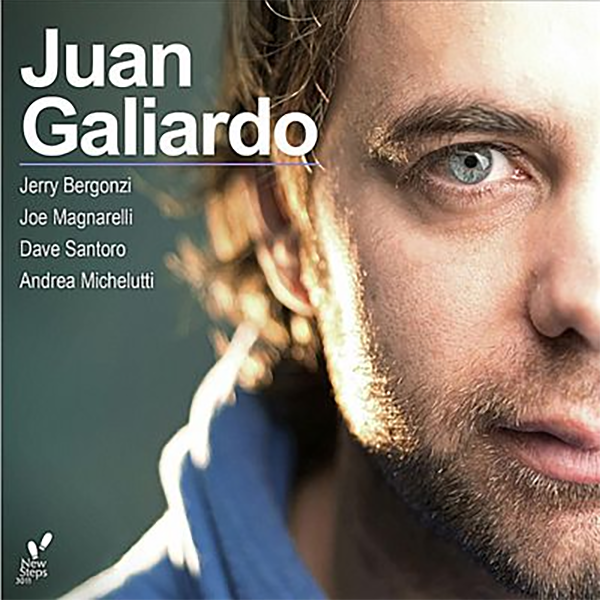
by Ian Mann
October 27, 2014
/ ALBUM
A classy, well crafted set of essentially mainstream jazz with some great playing and with the focus very much on beauty.
Juan Galiardo
“Juan Galiardo”
(NewSteps Records 3011)
Spanish pianist and composer Juan Galiardo visited the UK in May 2014 for a short tour of Wales co-leading a quartet with his fellow countryman Arturo Serra (vibes). Billed as “Espana Cyrmu” the two Spaniards were joined by local Welsh rhythm sections, the musicians including bassists Ashley John Long and Aidan Thorne and drummers Phil Redfox O’Sullivan and Mark O’Connor.
I saw two enjoyable performances (with two different rhythm sections) by the quartet at Abergavenny and Brecon, the latter a double bill with the Cardiff University Big Band. Both shows are reviewed elsewhere on this site. It was at Brecon that Galiardo was kind enough to give me a copy of his début album, yet another one that has sat lingering in the “to do” file for far too long.
Born in Seville Galiardo graduated from Cadiz University before moving to the US to study at the famous Berklee College of Music in Boston. While there he performed with a number of top American names including saxophonists Jerry Bergonzi and Donny McCaslin.
Released in 2012 this album features the talents of Boston native Bergonzi on tenor sax as part of a quintet also featuring Joe Magnarelli on trumpet, Dave Santoro on bass and Andrea Michelutti at the drums. The Espana Cymru tour largely limited itself to interpretations of standards but Galiardo’s album includes five of the pianists’ attractive original compositions alongside four well known standards by composers such as Cole Porter and Antonio Carlos Jobim.
The album opens with the Galiardo original “Kenny’s Mood” although it’s not made clear who the dedicatee is. I’d hazard a guess at Kenny Barron but it could just as well be Mr Wheeler or Mr Garrett. Whatever it’s a highly melodic piece with a lush blend of flugel and tenor and sensitive, understated rhythmic support featuring mainly brushed drums. Galiardo takes the first solo and demonstrates a light, lyrical touch. Bergonzi’s tenor solo is lyrical but is simultaneously incisive authoritative. Magnarelli maintains the mood with a warm toned flugel solo supported by Santoro’s rich bass undertow. With some delightful horn interplay in the closing stages of the tune this elegant original composition represents an excellent start.
Jobim’s “Girl from Ipanema” is a piece that’s pretty much been done to death but Galiardo’s thoughtful, slowed down quartet arrangement manages to shed some fresh light on it, helped enormously by Bergonzi’s assured fluency and the leader’s own flowing lyricism. The pair are given sympathetic rhythmic support with Michelutti’s neatly detailed drumming a significant feature in the success of the arrangement.
The original “Otaro Souko” explores rather different territory as a freely structured intro gives rise to a Latin inflected hard bop tune with insistent rhythms and a harder edged solo from Bergonzi leading things off. Magnarelli brings a warm, breezy fluency to his flugel solo and Galiardo sounds positively joyous. Santoro and Michelutti provide effortlessly swinging support.
Cole Porter’s “So in Love” is a piece for piano trio only, Galiardo relishing the opportunity to stretch out above Santoro’s busy bass walk and the bustle of Michelutti’s drums, lyricism combining with swing as the trio vary the tempo with considerable aplomb.
I’m assuming that the group’s bassist is the dedicatee of the lively “Blues For Dave”. Ushered in by Michelutti’s drums this is a fast moving piece which incorporates a powerful opening statement from Bergonzi who solos with an obvious relish. Galiardo is lively and fluent as is Magnarelli on trumpet. Santoro and Michelutti offer splendidly propulsive support.
Another standard, Sammy Cahn’s “I Fall In Love Too Easily” is given a true balled reading by the trio of Galiardo, Santoro and Michelutti. Lyrical solo piano opens the proceedings and there’s also a delightful solo from Santoro, dexterous, resonant and melodic. Michelutti’s brush work is immaculate throughout and Galiardo is flowingly lyrical.
The Galiardo original “Window Fall” is another ballad, this time a feature for the velvety sound of Magnarelli and the bitter sweet tenor of Bergonzi plus Galiardo’s trademark lyricism. The support from bass and drums is characteristically sympathetic and well judged.
The final standard, “I Hear A Rhapsody” is a final piano trio piece with Galiardo, Santoro and Michelutti displaying their talents at a faster, but still tasteful, tempo. Santoro shines again on his solo and Michelutti enjoys a series of nimble drum breaks.
The closing “Buenas Noches por Venir” is a Latin inflected quartet piece that features Bergonzi at his best, fluent but slightly acerbic, his sound always striking a good balance between sugar and vinegar. It’s very much a showcase for the album’s star guest but Galiardo also impresses with his final solo of a very enjoyable set.
The album as a whole represents an impressive statement from Galiardo. A well programmed collection of tunes features a variety of instrumental configurations and despite the presence of a big name saxophonist in Bergonzi Galiardo is anything but overawed and it’s very much his album.
Both horn men make telling contributions and Santoro and Michelutti are both excellent throughout.
Galiardo’s original tunes are thoroughly convincing and the arrangements of the standards consistently interesting. Recorded at FJR Studio in Granada the sound quality is top notch with credit due to engineer Fernando Romero and to producer Galiardo.
There’s nothing particularly radical about Galiardo’s album but it’s a classy, well crafted set of essentially mainstream jazz with some great playing and with the focus very much on beauty. A strong team effort it represents a very enjoyable listen and is a record that will repay return visits.
blog comments powered by Disqus